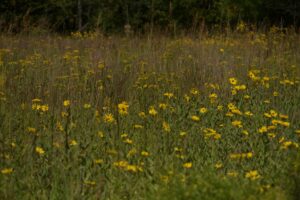Ripples from the Dunes contributed from the Dunesletter archives, September 1985, Number 41. Written by John Hancock.
Nature’s Timetable
Asters, goldenrods and gentians are characteristic flowers of late summer and fall. When we see these flowers in bloom, we know that summer is waning and fall will soon be here. Most asters and goldenrods grow to their full size in early summer, then seem to mark time for as long as two months. Why do they wait before blooming until summer is nearly over? What establishes the timetable by which plants flower?
 Over fifty years ago, scientists began experimenting to try to find the answers to these questions. They found that such factors as temperature, moisture, and nutrition may delay blooming, or in extreme cases, may prevent it from occurring. But flowering time is actually controlled by the hours of sunlight in the day. From their early experiments, scientists were able to sort plants into three categories: short-day, long-day, and day-neutral.
Over fifty years ago, scientists began experimenting to try to find the answers to these questions. They found that such factors as temperature, moisture, and nutrition may delay blooming, or in extreme cases, may prevent it from occurring. But flowering time is actually controlled by the hours of sunlight in the day. From their early experiments, scientists were able to sort plants into three categories: short-day, long-day, and day-neutral.
Short-day plants do not bloom if the day length is greater than a critical maximum. Some of them bloom in late summer and early spring, others in late summer and fall. Those that flower in spring usually have short delicate stems and few leaves that are small in size. Thus, when air and soil temperatures are right in spring, they are able to quickly push up their leaves and buds and complete their flowering cycle before the day-length reaches the critical maximum. These may be plants that did not flower during the normal period in spring.
Short-day plants of late summer and fall are usually taller and leafier than their counterparts of spring. They spend the spring and summer building their stems, leaves and roots. Then, when the day length falls below their critical maximum, they flower. Short-day plants are unable to grow in the far north if their seeds cannot ripen before the cold weather kills them.
Long-day plants are unable to bloom until the length reaches a critical maximum value. Therefore, they flower only in late spring and early summer. Like the short-day plants of fall, they spend the early part of spring growing their stems and leaves. The do not flower until the critical day length is reached. Then they may continue to bloom until the day length decreases again to the critical minimum. Long-day plants are unable to bloom in tropical areas where there is little variation in day length.
Day-neutral plants are the exceptions to the rule; they are not controlled by the length of the day. They can flower any time environmental conditions are right. They are very adaptable and are able to grow in a great variety of climates.
Individual species of plants may show variations form these simple responses to day length. Some species require repeated exposure to the critical day length for several days to trigger their flowering response, others respond after a single day. The critical day length itself is different for each species.
Further scientific experimentation studied the effects of variations in lighting on the flowering response. Changes in light intensity were found to have no effect. Thus, cloudy days have the same effect as sunny days.
Strictly speaking, it is not the length of the day that is critical to plant flowering, but the length of the night. If night is interrupted, as by a burst of artificial light, even for as little as a minute, the plant responds as though the night was much shorter. Florists have used this process to force plants to bloom outside their normal periods. Short-day plants, such as chrysanthemums and poinsettias can be held in non-flowering condition until the desired time. Long-day plants can be kept flowering into fall and winter.
The short-day plants of fall have been successful because they are able to set seed and propagate themselves in the short time between their flowering and the onset of the killing cold. Goldenrods and asters have evolved into many species, each occupying a slightly different habitat and each blooming at a slightly different time. Watch for them and the other fall flowers as the season advances.
Photo: Woodland Dunes prairie with Coreopsis Tripteris, species in the Asteraceae family
